

Objective of the experiments:
The aim of the FRSP is to test the 'Frozen Reality'-procedure for space- capability and to show, that it can be used for research under weightlessness in future. Many fast - moving, complex experiments and processes can be visualized, examined and they can even be demonstrated scientifically to the layman, e.g. the phenomenon of surface tension in liquids, the behaviour of projectiles in collisions with other objects, the dispersion or structural development of dust particles, and much more...
To qualify the FR-instrument under the condition of weightlessness, experiments will be carried out which could contribute to current areas of research in space flight. One experiment will deal with the analysis and investigation of collisions - for example the impact of small objects or ice particles on the surface of satellites or into solar panels: another experiment will examine the behaviour of liquids under weightlessness and further processes could be tested.
Moreover another great advantage of these experiments is the chance that the results may draw the public`s attention to processes under weightlessness in space by showing attractive pictures and short films which could fascinate a lot of people.
The experimental setup - the entire plant:
The entire plant devised for the accomplishment of experiments under the condition of zero gravity (0g) is described in the following part:

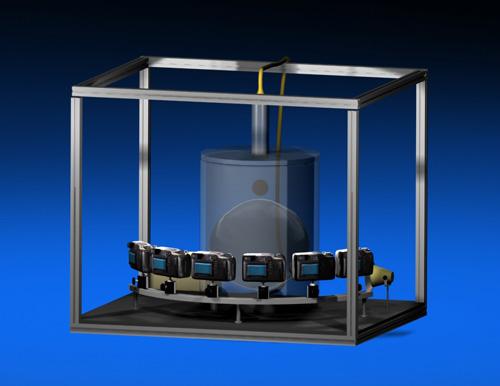
Fig. E1: photo of the planned picture-taking equipment: At the front is the camera equipment: in the background you can see the cylinder (made of acrylic glass), in which the experiments take place- shown above: an experiment with a liquid. (source: Florian Maier)
To perform 'Frozen Reality'-experiments in space, changes in the picture-taking equipment are needed, which should be as follows:
First of all the whole construction of the plant should be compact and light, avoiding unnecessary ballast - but still providing security and robustness. Most important is secure transportation, stable lodging and attachment in the plane and the safe performance of the experiments. Therefore all example experiments must take place in a separate space to avoid risks to technical equipment or accompanying persons. However, this space must be visible from the outside, which is especially important for the picture-taking. The solution for this is a transparent cylinder of acrylic glass, which is mounted in the middle of the equipment. ( see fig. E1 ). In this plexiglas cylinder, the experiment is mounted already before the flight. The plexiglas cylinder can be removed, so that different experiments can be performed by changing the plexiglas cylinder which contains the particular experiments.
There will be irregularities during the flight and therefore absolute weightlessness (+/-0.01g) is not possible, so we plan to attach all the experimental equipment to a special hanging gadget so that it almost levitates. Through this, the miniscule fluctuations in the flight parabola can be adjusted.
The cylinder consists of a cover module, where the experiments are attached, and a conical discharge (4), which is necessary for the experiments with liquids (see fig. E2). When the effect of gravity returns, the discharge will assure the removal of oddments from the experiment. Thus, the cylinder can be used several times for one experiment with different parameters. During experiments with liquids the module is attached to an adjustable pump (2) including a reservoir for the liquid.
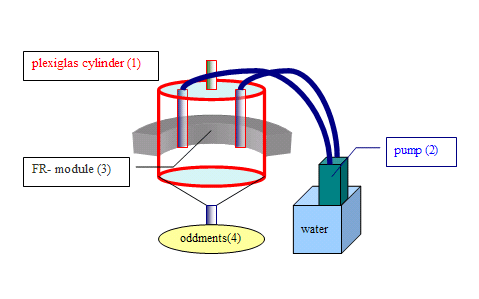
Fig. E2: picture of the planned photographic equipment in principle: In the background there is the camera equipment, at the front you can see the cylinder (made of acrylic glass), in which the experiments take place- shown above: an experiment with a liquid. (source: Benjamin Holfeld)
It is intended to arrange the 'Frozen Reality' photographing module around the transparent cylinder. Several photo cameras (in this case: 6 ones) are fixed in a steady bend with their lenses all directed at the experiment in the cylinder. At one end of the 'Frozen Reality' photographing module there is a high-speed camera, which enables us to take a time-dynamic recording in addition to the local-dynamic 'Frozen Reality' photo. During impact experiments the cameras are activated by a shock-susceptible module (Piezo-crystal), in experiments with liquids by other appropriate sensors, which will be adapted to the particular experiment.
The fundamental test sequence:
As soon as the aircraft has reached the turning point of the parabola course, the 20 second period of weightlessness begins. For this perod the almost floating experiment - which is only limited by the outside framework, screwed to the floor of the airplane for safety reasons - will be aligned in such a way that it has enough free play, in order to adjust minimum fluctuations of the airplane and to achieve a phase of weightlessness which is as troublefree as possible.
When the floating experiment is stabilized, the tests will be started and the photos will be taken. Here we have to distingiush between two phases per experiment:
Within the first part of every test a high speed camera is used (phase 1), in order to log the temporal operational sequence. Thus one receives a time-dynamic (but local-fixed) representation of the experiment during the entire 20 seconds of weightlessness, which in particular might be interesting regarding the tests of liquids.
Within the second part of every test the 'Frozen Reality'-procedure is applied (phase 2), at the same time the most exciting moment will be 'frozen' photographically (concerning the fracture tests this is the moment of the impact of the projectile on the sample). The result is going to be a local dynamic representation of this moment. Particularly fast running procedures must be darkened from outsideby covering the entire testing plant before starting the test (for example by a black cloth), because the exposure takes place with the help of an ultrashort flashlight (released by the above-mentioned trigger circuit and/or the Piezo module).
By restoring the force of gravity the structure of experiment is latched secure at the bottom of the safeguarding framework. Then the experiment can be changed possibly (by replacing the plexiglass cylinder).
To test and qualify the 'Frozen Reality'-experiment plant for space extensively, there will be several test experiments. Two experiments have already been planned (see following paragraphs), further experiments are in preparation...
Test experiment 1 (the impact of small projectiles):
This experiment is made to analyse the impact process of small projectiles, for example particles of comets (lumps of ice and dust), stones or circulating space scrap, into the casing of artificial space objects like satellites, solar cells, spaceships or space stations. Therefore a small projectile is shot on a particular material (e.g. glass).
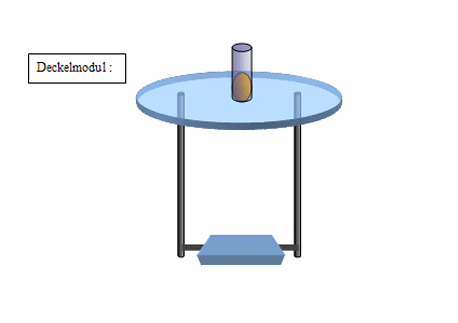
Fig. E3: The experiment's module to simulate the impact of the small projectile in principle. The projectile (black, round object) hits a glass plate (grey). (source: Benjamin Holfeld)
Two grip handles are fastened at the module of the lid which fix a glass plate at the same level as the 'Frozen Reality'-cameras. After the commencement of zero gravity the small projectile is accelerated towards the glass plate by an air pressure pump.
Before that several velocities and the particular formation of fractures are tested under conditions of gravitation on earth. These results are compared to those made under conditions of zero gravity. The fragment's dispersion and the distribution of the dust are particularly interesting while investigating this. A high speed camera ought to provide information about the impact process and object movements in lapse of time
Test experiment 2 (experiment with liquids):
The aim of this experiment is to investigate the behaviour and interaction of liquids under weightlessness. The interesting aspect of this test is the visual examination of water accumulation (which is spherical under weightlessness) in collision with a projectile, especially the expected wavelike dispersion of the impact impulse of the projectile in the liquid ball. Thereby knowledge could be acquired about the (flow-) behaviour of liquids at mechanical interferences in a tank for liquids under weightlessness (e.g. in space stations).
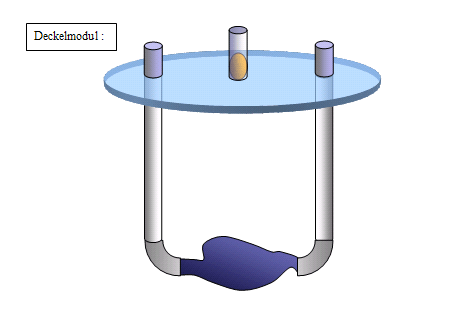
Fig. E4: Experiment module to examine the behaviour of liquids: The projectile (black, round object) hits the liquid accumulation (blue). (source: Benjamin Holfeld)
To get a solid water sphere and to avoid contact with the cylinder, weightlessness which is as stable as possible is needed, which should be achieved by a special floating suspension of the experiment equipment in the plane.
Three variants were conceived for the creation of a water sphere. The generation of the sphere and the effects going hand in hand with the generation could be very interesting and will be recorded by using a high speed camera.
The first variant: Two small pipes are mounted at the cover module with the pipe muzzles facing each other exactly. The small projectile is situated in the middle of the cover module. Liquids (water, possibly with coloured floating materials) approach slowly by using supply pipes from the left and from the right. These liquids must be mixed and stopped in the middle of the cylinder because of the conservation of momentum - apart from irregularities and interferences.
The second variant: Alternatively the liquid could be pumped slowly through a special single pipe at the bottom of the cylinder.
The third variant is to provide a cylinder with water repellent surface, filled already to ¼ with water. ( see Fig. E5 ) To get a minimum surface and to lower surface energy, the liquid will form into a sphere:
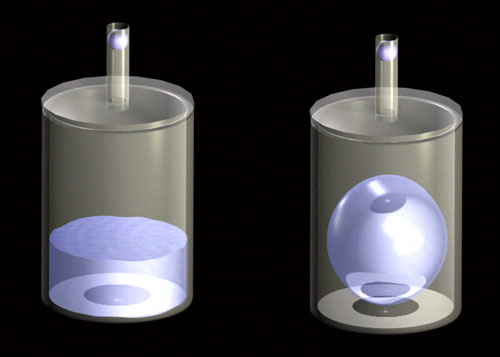
Fig. E5: Variant 3 to get a solid water sphere. The cylinder is made of water repellent material. Under the conditions of weightlessness, the water will form into a sphere, to lower surface energy. (Quelle: Benjamin Holfeld)
This liquid sphere is going to be shot through by a small projectile, accelerated by air pressure. The first time, the whole process will be recorded by using a high speed camera. The second time, interesting moments (short-time after the impact) will be recorded with the help of 'Frozen Reality'. The result is a threedimensional view of a millionth second moment during the impact.
During the 60 parabolic flights altogether, each with 20 second microgravity, the experiments can be repeated with different parameters and can be performed more exactly with investigations in detail. Furthermore additional test experiments have been planned, but they have not been specified yet.